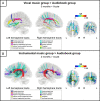Post-stroke enriched auditory environment induces structural connectome plasticity: secondary analysis from a randomized controlled trial
- PMID: 35352235
- PMCID: PMC9279272
- DOI: 10.1007/s11682-022-00661-6
Post-stroke enriched auditory environment induces structural connectome plasticity: secondary analysis from a randomized controlled trial
Abstract
Post-stroke neuroplasticity and cognitive recovery can be enhanced by multimodal stimulation via environmental enrichment. In this vein, recent studies have shown that enriched sound environment (i.e., listening to music) during the subacute post-stroke stage improves cognitive outcomes compared to standard care. The beneficial effects of post-stroke music listening are further pronounced when listening to music containing singing, which enhances language recovery coupled with structural and functional connectivity changes within the language network. However, outside the language network, virtually nothing is known about the effects of enriched sound environment on the structural connectome of the recovering post-stroke brain. Here, we report secondary outcomes from a single-blind randomized controlled trial (NCT01749709) in patients with ischaemic or haemorrhagic stroke (N = 38) who were randomly assigned to listen to vocal music, instrumental music, or audiobooks during the first 3 post-stroke months. Utilizing the longitudinal diffusion-weighted MRI data of the trial, the present study aimed to determine whether the music listening interventions induce changes on structural white matter connectome compared to the control audiobook intervention. Both vocal and instrumental music groups increased quantitative anisotropy longitudinally in multiple left dorsal and ventral tracts as well as in the corpus callosum, and also in the right hemisphere compared to the audiobook group. Audiobook group did not show increased structural connectivity changes compared to both vocal and instrumental music groups. This study shows that listening to music, either vocal or instrumental promotes wide-spread structural connectivity changes in the post-stroke brain, providing a fertile ground for functional restoration.
Keywords: Environmental enrichment; Music; Rehabilitation; Stroke; Structural connectivity.
© 2022. The Author(s).
Conflict of interest statement
Not applicable.
Figures


Similar articles
-
Vocal music enhances memory and language recovery after stroke: pooled results from two RCTs.Ann Clin Transl Neurol. 2020 Nov;7(11):2272-2287. doi: 10.1002/acn3.51217. Epub 2020 Oct 6. Ann Clin Transl Neurol. 2020. PMID: 33022148 Free PMC article. Clinical Trial.
-
Vocal music listening enhances post-stroke language network reorganization.eNeuro. 2021 Jun 17;8(4):ENEURO.0158-21.2021. doi: 10.1523/ENEURO.0158-21.2021. Online ahead of print. eNeuro. 2021. PMID: 34140351 Free PMC article.
-
Resting-state language network neuroplasticity in post-stroke music listening: A randomized controlled trial.Eur J Neurosci. 2021 Dec;54(11):7886-7898. doi: 10.1111/ejn.15524. Epub 2021 Nov 16. Eur J Neurosci. 2021. PMID: 34763370 Clinical Trial.
-
Neural architectures of music - Insights from acquired amusia.Neurosci Biobehav Rev. 2019 Dec;107:104-114. doi: 10.1016/j.neubiorev.2019.08.023. Epub 2019 Aug 31. Neurosci Biobehav Rev. 2019. PMID: 31479663 Review.
-
Music listening after stroke: beneficial effects and potential neural mechanisms.Ann N Y Acad Sci. 2012 Apr;1252:266-81. doi: 10.1111/j.1749-6632.2011.06405.x. Ann N Y Acad Sci. 2012. PMID: 22524369 Review.
Cited by
-
Enriched Environments in Stroke Units: Defining Characteristics and Limitations.HERD. 2024 Apr;17(2):344-359. doi: 10.1177/19375867231224972. Epub 2024 Mar 18. HERD. 2024. PMID: 38494920 Free PMC article.
-
Enriched rehabilitation on brain functional connectivity in patients with post-stroke cognitive impairment.Front Neurol. 2025 Jan 7;15:1503737. doi: 10.3389/fneur.2024.1503737. eCollection 2024. Front Neurol. 2025. PMID: 39845930 Free PMC article.
-
Assessing stress using repeated saliva concentration of steroid hormones in dementia care dyads: results from a controlled pilot care music intervention.Ups J Med Sci. 2023 May 5;128. doi: 10.48101/ujms.v128.9340. eCollection 2023. Ups J Med Sci. 2023. PMID: 37265585 Free PMC article.
-
Overnight olfactory enrichment using an odorant diffuser improves memory and modifies the uncinate fasciculus in older adults.Front Neurosci. 2023 Jul 24;17:1200448. doi: 10.3389/fnins.2023.1200448. eCollection 2023. Front Neurosci. 2023. PMID: 37554295 Free PMC article. Review.
-
Structural and functional neuroplasticity in music and dance-based rehabilitation: a systematic review.J Neurol. 2025 Apr 9;272(5):329. doi: 10.1007/s00415-025-13048-6. J Neurol. 2025. PMID: 40204940 Free PMC article.
References
-
- Baylan S, Haig C, MacDonald M, Stiles C, Easto J, Thomson M, Cullen B, Quinn TJ, Stott D, Mercer SW, Broomfield NM, Murray H, Evans JJ. Measuring the effects of listening for leisure on outcome after stroke (MELLO): A pilot randomized controlled trial of mindful music listening. International Journal of Stroke. 2020;15(2):149–158. doi: 10.1177/1747493019841250. - DOI - PMC - PubMed
Publication types
MeSH terms
Grants and funding
LinkOut - more resources
Full Text Sources
Medical

